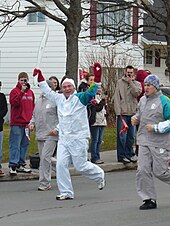 | |
| Host city | Vancouver, Canada |
|---|---|
| Countries visited | Greece, Canada, United States See full route |
| Torchbearers | 12,000 approx. |
| Start date | October 30, 2009 |
| End date | February 12, 2010 |
| Torch designer | Leo Obstbaum |
| Part of a series on |
| 2010 Winter Olympics |
|---|




The 2010 Winter Olympics Torch Relay was a 106-day run, from October 30, 2009, until February 12, 2010, prior to the 2010 Winter Olympics. Plans for the relay were originally announced November 21, 2008, by the Vancouver Organizing Committee for the 2010 Olympic and Paralympic Winter Games (VANOC). Communities were initially informed in June 2008, but the locations were not announced for "security reasons". [1] Exact routes were later announced several weeks before the start of the torch relay. [1]
Contents
The torches used in the Olympic relay were designed by Leo Obstbaum (1969–2009), the late director of design for the 2010 Winter Games. [2]
There were an estimated 12,000 torchbearers, including notable Canadian celebrities such as Shania Twain, Simon Whitfield, Silken Lauman, Alexandre Despatie, Catriona Le May Doan and John Hayman and past and present NHL hockey stars including Sidney Crosby, Wayne Gretzky, and the captains of the Vancouver Canucks teams that went to the Stanley Cup Finals, Trevor Linden (1994) and Stan Smyl (1982). In fact, many television personalities were selected as torchbearers for the relay, mainly from CTV's parent company, CTVglobemedia. Matt Lauer and American actor, bodybuilder, and former California Governor Arnold Schwarzenegger were also torch bearers. [3]
On 22 October 2009 the Olympic Torch was lit during a ceremony held at the Ancient Olympia in Greece. Actress Maria Nafpliotou played the role of the High Priestess and ignited the flame using a parabolic mirror and the sun's ray. The first torch was carried by Olympic skier Vassilis Dimitriadis. [4]
Kept under close secrecy, the final Olympic Torchbearer turned out to be not one, but five final torchbearers. Rick Hansen brought it into BC Place Stadium, in turn lighting Catriona Le May Doan's torch, who lit Steve Nash's torch, and the flame continued to Nancy Greene and Wayne Gretzky. Three of the four torchbearers lit the indoor Olympic Cauldron; Le May Doan remained with her torch due to a malfunction causing only three of the four arms to be raised. Gretzky exited BC Place, with his torch still lit, and caught a ride on the back of a VANOC vehicle, to Coal Harbour, where he lit the outdoor Cauldron. This makes Gretzky the first person to light two official cauldrons in the same Olympics.
At the start of the closing ceremony, Le May Doan re-lit the indoor Cauldron after clown and mime Yves Dagenais "fixed" and "raised" the arm that malfunctioned in the opening ceremony.